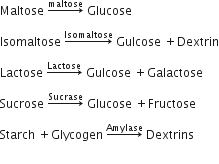 Long Answer Type
Long Answer Type(a) Explain in detail the digestion of carbohydrates, as the food passes through the alimentary canal.
(b) Describe step by step what happens in the different phases of the cardiac cycle in human beings.
(c) Write the effects of cytokinins on plants.
(a) Digestion of Carbohydrates : Digestion of carbohydrates begins in the buccal cavity. Saliva contains the enzyme ptyalin or salivary amylase. It hydrolyses some starch into maltose, isomaltose and dextrin.
Gastric juice does not contain any carbohydrate digesting enzyme. Hence no digestion of carbohydrate takes place in stomach.
Pancreatic juice contains amylopsin or pancreatic amylase. It hydrolyses the remaining starch into maltose, isomaltose and dextrin.
Pancreatic anylase operates in alkaline medium (pH-8.8) which is provided by the bicarbonates present in bile and pancreatic juice.
The intestinal juice contains a number of carbohydrate digesting enzymes which complete the digestion of carbohydrates. These are :
All these enzymes operate in alkaline medium (pH-8).
(b) Cardiac ccle is the sequence of events, which occur from the beginning of one heartbeat to the beginning of the next . During the cardiac cycle, the phase of contraction is called systole and the phase of relaxation is diastole. The pumping action during single cardiac cycle involves the following steps :
(i) Atrial systole : Under normal conditions, blood continuously enters into right atrium through superior vena cava, as well as inferior vena cava and coronary sinus. The pulmonary veins bring blood to the left atrium from lungs. From the atria, nearly 70% of the blood passively flows into the ventricles. Rest of the blood is pumped into the ventricle by the contraction of atria. The arrangement of valve is such that it allows the flow of blood from atria to ventricles. Atrial systole lasts for about 0.15 second.
(ii) Ventricular filing : As soon as the atrioventricular valve opens, nearly one third of the ventricle is filled. Rest of the ventricular filling takes place during the contraction of the atria.
(iii) Ventricular systole : When the atrial systole approaches its end, the action potential passes from SA node to the AV node, as well as the ventricles. Consequently, the ventricles contract which results in the rise of ventricular pressure and both the atrioventricular valves are closed to prevent the back flow of blood. The contraction of ventricle is so strong that the ventricular pressure exceeds the aortic pressure, as a result of which, the semilunar valve opens. Now, the blood is pumped into the respective arteries. Ventricular systole lasts for about 0.25 second.
(iv) Ventricular diastole : The ventricular systole is followed by ventricular diastole, during which there is a fall in ventricular pressure. The semilunar valves close to prevent back flow of blood from aortas. At the same time, the AV valve opens to allow the flow of blood from both the atria to the respective ventricles.
(c) Effects of Cytokinins
(1) Promotes cell division.
(2) Delays senescence
(3) Nutrient mobilisation .
(4) Promotion of seed germination: Application of cytokinins promote germination.
(5) Morphogenetic effects : The ratio of auxin and cytokinin is the determining factor in controlling initiation of roots and buds.
(a) Write about the chemical changes which occur during contraction of skeletal muscles.
(b) Draw a neat labelled diagram of the L.S. of a kidney.
(c) What is chloride shift ?
a) Explain how the human ear helps in hearing.
b) Briefly describe the events that occur during the prolifearative phase of the menstrual cycle.
(c) Mention the site of secretion and function of the following :
(i) Glucocorticoids
(ii) Calcitonin
(iii) Glucagon
(a) Explain the evolution of the long neck of giraffe according to Darwin and Lamarck.
(b) Explain briefly :
(i) Environmental resistance
(ii) Albinism
(iii) Plant introduction
(iv) Palaeontology
(c) Write two uses of each of the following :
(i) Emblica officinalis
(ii) Adhatoda vasica
(a) Give four applications of tissue culture in crop improvement.
(b) What do you understand by the term population growth ? Give three ways of discouraging population growth.
(c) Define :
(i) Coacervates
(ii) Gene bank
(a) Explain the role of Rh factor in blood incompatibility.
(b) State the main morphological changes that occurred in the ancestors of modern man.
(c) Describe briefly the functions of the following :
(i) CT Scan
(ii) External prosthesis
(iii) Pacemaker
a) Explain the role of a genetic counsellor.
(b) Write the causative agent and the main symptoms of the following diseases,
(i) Poliomyelitis (ii) Typhoid
(iii) Tuberculosis (iv) Cholera
(c) State two'similarities between the chromosomes of man and apex.
